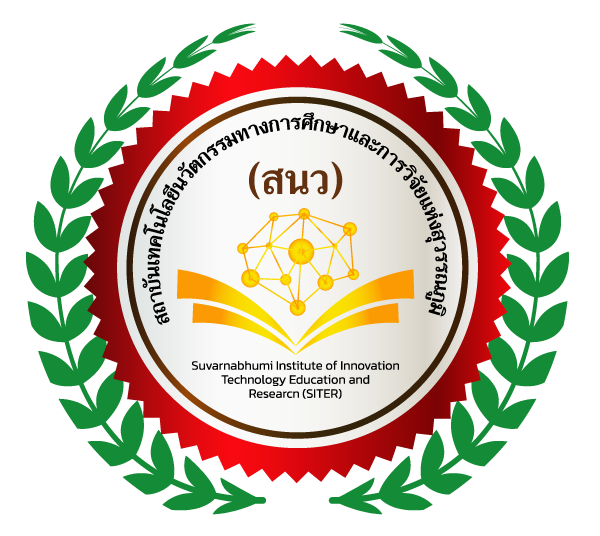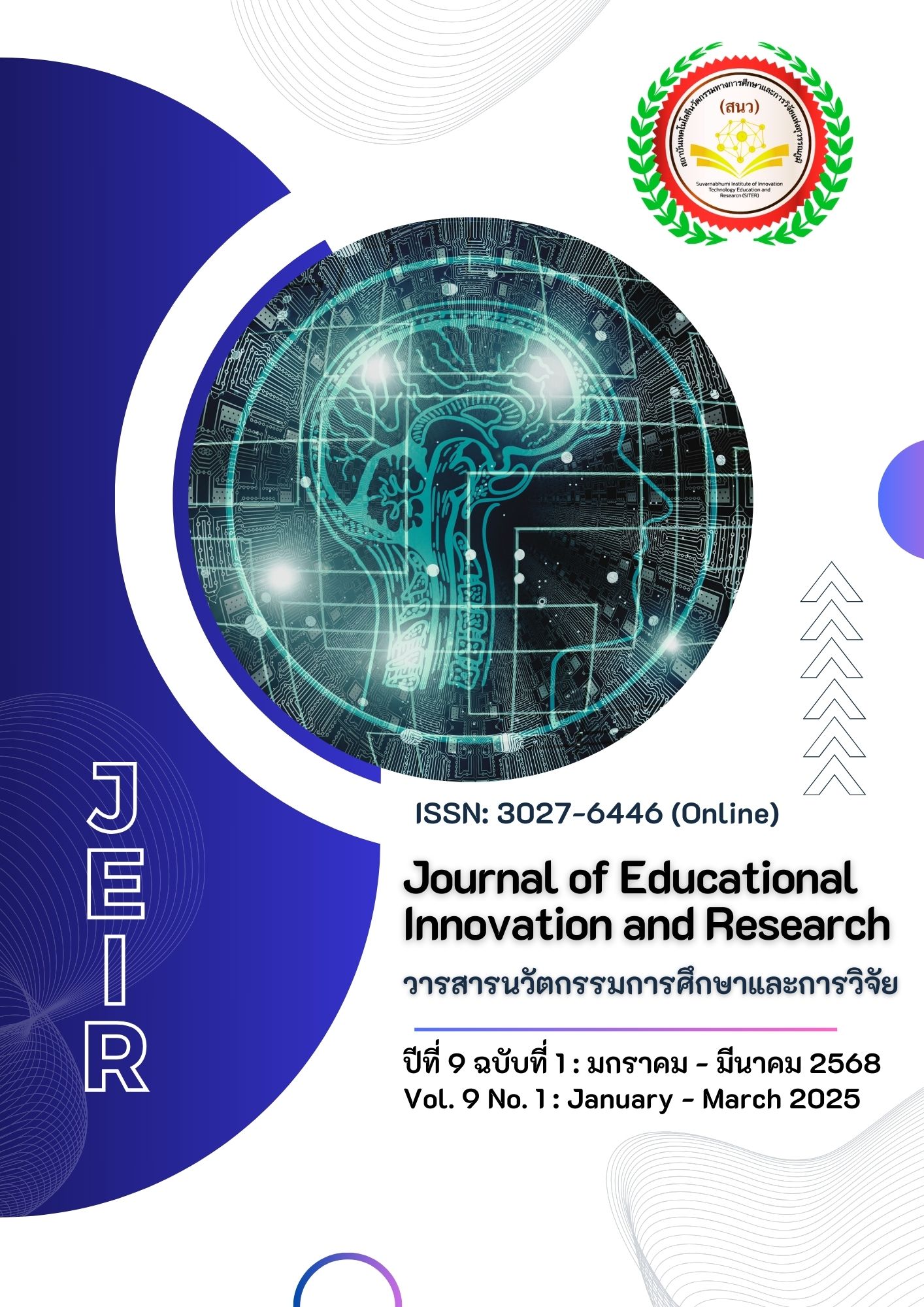การพัฒนาชุดการเรียนรู้รายวิชาชีววิทยา ตามแนวคิดเชิงออกแบบ ร่วมกับอิงสถานที่เป็นฐาน เพื่อส่งเสริมทักษะการคิดเชิงระบบ และเจตคติ ต่อสิ่งแวดล้อม สำหรับนักเรียนชั้นมัธยมศึกษาปีที่ 5
Main Article Content
บทคัดย่อ
บทความนี้มีวัตถุประสงค์เพื่อ 1) พัฒนาและหาประสิทธิภาพชุดการเรียนรู้รายวิชาชีววิทยาตามแนวคิดเชิงออกแบบร่วมกับอิงสถานที่เป็นฐาน 2) ศึกษาผลการเรียนรู้รายวิชาชีววิทยา ก่อนเรียนและหลังเรียน 3) ศึกษาทักษะการคิดเชิงระบบก่อนเรียน ระหว่างเรียน และหลังเรียน และ 4) ศึกษาพัฒนาการเจตคติต่อสิ่งแวดล้อมของนักเรียน เป็นการวิจัยประเภทการวิจัยและพัฒนา ตัวอย่างการวิจัย ได้แก่ นักเรียนชั้นมัธยมศึกษาปีที่ 5/1 ที่กำลังเรียนในภาคเรียนที่ 1 ปีการศึกษา 2567 จำนวน 29 คน ได้มาโดยวิธีการสุ่มอย่างง่าย (Sample random sampling) เครื่องมือที่ใช้ในการวิจัย ได้แก่ 1) ชุดการเรียนรู้รายวิชาชีววิทยา ตามแนวคิดเชิงออกแบบร่วมกับอิงสถานที่เป็นฐาน 2) แผนการจัดการเรียนรู้ 3) แบบทดสอบวัดทักษะการคิดเชิงระบบ 4) แบบสังเกตพฤติกรรมการคิดเชิงระบบ และ 5) แบบประเมินเจตคติต่อสิ่งแวดล้อม วิเคราะห์ข้อมูลโดยใช้ค่าร้อยละ ค่าเฉลี่ย ค่าส่วนเบี่ยงเบนมาตราฐาน และ การทดสอบค่าที (Dependent Samples t–test)
ผลการวิจัยพบว่า 1) ชุดการเรียนรู้รายวิชาชีววิทยาที่ผู้วิจัยพัฒนาขึ้น จำนวน 4 เล่ม ได้แก่ เล่มที่ 1 เรื่องเหลือเชื่อ เนื้อเยื่อพืช เล่มที่ 2 ถอดรหัสบริษัทขนส่งอาหารของพืช เล่มที่ 3 ความมหัศจรรย์ของร่างกายพืช และ เล่มที่ 4 ห้องครัวของพืช มีค่าประสิทธิภาพเท่ากับ 82.45/80.69 82.31/81.03 82.15/80.69 และ 82.39/81.72 ตามลำดับ และมีค่าประสิทธิภาพเฉลี่ยรวมเท่ากับ 81.16/80.71 2) ผลการเรียนรู้มีค่าเฉลี่ยคะแนนหลังเรียนสูงกว่าก่อนเรียนอย่างมีนัยสำคัญทางสถิติที่ระดับ .05 3) ทักษะการคิดเชิงระบบหลังเรียนสูงกว่าก่อนเรียนอย่างมีนัยสำคัญทางสถิติที่ระดับ .05 และมีพัฒนาการเพิ่มขึ้นจากระดับพอใช้เป็นระดับดี ตามลำดับ และ 4) เจตคติต่อสิ่งแวดล้อมของผู้เรียนมีการพัฒนาขึ้นระหว่างเรียนโดยใช้ชุดการเรียนรู้รายวิชาชีววิทยาที่ผู้วิจัยพัฒนาขึ้นจากระดับพอใช้เป็นระดับดี
Article Details

อนุญาตภายใต้เงื่อนไข Creative Commons Attribution-NonCommercial-NoDerivatives 4.0 International License.
เอกสารอ้างอิง
Barroso, K., & Pon, S. (2005). Effective lesson planning, A facilitator’s guide. California Adult Literacy Professional Development Project. American Institutes for Research, Sacramento, CA.
Brahmawong, C. (2012). Developmental Testing of Media and Instructional Package. Silpakorn Educational Research Journal, 5(1), 7-19.
Brown, T. (2009). Change by Design. Harper Collins Publisher.
Bucha, S., & Chookhampaeng, S. (2020). The Development of Learning Activity in Biology by Design Thinking with Participatory Learning to promote Creativity of grade 11th students. Journal of MCU Nakhondhat, 7(12). 220-221.
Bunjong, V., & Khayankij, S. (2013). Effects of Organizing Art Experiences by Integrating Design Thinking approach on Kindergarteners’ Creativity [Doctoral dissertation, Chulalongkorn University].
Chaikitpinyo, S. (2004). How to do with teaching and learning to instill morality and ethics. Journal of Education and Innovative Learning, 1(1), 3-7.
Checkland, P. (1981). Systems Thinking, Systems Practice. John Wiley & Sons, New York.
Chitkul, S. (2007). Systems thinking with the development of the case: study the case of NBTC Telecommunications Public Company Limited [Master’s Thesis, National Institute of Development Administration].
Choueiri, L. S., & Mhanna, S. (2013). The Design Process as a Life Skill. Procedia - Social and Behavioral Sciences, 93, 925–929.
Chunphoon, W. (2021). Place-Based Education for Promoting Environmental Literacy in Human and Natural Resources and Environmental Sustainability for Grade 12 Students [Master’s independent study, Naresuan University].
Cross, N. (2006). Designedly ways of knowing. Springer-Verlag.
Doppelt, Y. (2009). Assessing creative thinking in design-based learning. International Journal of Technology and Design Education, 19(1), 55-65.
Israsena Na Ayudhya, P., & Treerattanaphan, C. (2017). Design thinking: Learning by doing. http://resource.tcdc.or.th/ebook/Design.Thingking.Learning.by.Doing.pdf
Jatuporn, O., & Wattanatorn, A. (2015). Place-Based Education: The Development of Good Citizenship in Youth Based on Community Contexts. Journal of Social Sciences and Humanities Research in Asia, 21(1), 81-112.
Martin, R. (2010). Design Thinking: Achieving Insights via the “Knowledge Funnel”. Strategy and Leadership, 38, 37-41.
Ministry of Education. (2022). Press conference on PISA 2022 assessment results. https://pisathailand.ipst.ac.th/news-21/
Nillapun, M. (2010). Educational Research Methods (5nd ed.). Silpakorn University.
Noppakun, N. (2548). Systems Thinking. Journal of Technical Education Development, 55(17), 36-42.
Office of the National Economic and Social Development Board. (2017). National Economic and Social Development Plan No. 12. Office of the National Economic and Social Development Board.
Office of the Secretariat of the Education Council. (2021). Report on the status of Thai education in 2020. Office of the Secretariat of the Education Council.
Sirisakdi, P. (2004). The development of an environmental science instructional model based on place-based education approach to promote sense of place and environmental literacy of lower secondary school students [Doctoral dissertation, Chulalongkorn University].
Srisa-ard, B. (2002). Basic research (7nd ed.). Suviriyasasana.
Smith, G. A. (2002). Place-based education: Learning to be where we are. Phi Delta Kappan, 8(3), 584-594.
Sterling, S. (2001). Sustainable Education – Re-visioning learning and change, Schumacher Briefing no 6. Schumacher Society/Green Books, Dartington.
Tayaputch, T. (2002). A Development of Mastery Learning Self - Study Package on Equation and Equation Solving for Prathomsuksa 6 students [Master’s Thesis, Silpakorn University].
The Institute for the Promotion of Teaching Science and Technology. (2017). Manual for using the additional science curriculum, biology subject, high school level Science learning group (Revised edition 2017). Agricultural Cooperatives Association of Thailand Co., Ltd.
Yemini, M., Engel, L., & Ben Simon, A. (2023). Place-based education – a systematic review of literature. Educational Review, 1–21.


